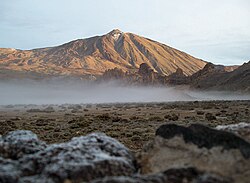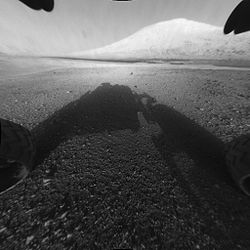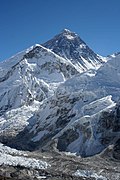Top Qs
Timeline
Chat
Perspective
List of tallest mountains in the Solar System
From Wikipedia, the free encyclopedia
Remove ads
This is a list of the tallest mountains in the Solar System. This list includes peaks on all celestial bodies where significant mountains have been detected. For some celestial bodies, different peaks are given across different types of measurement. The solar system's tallest mountain is possibly the Olympus Mons on Mars with an altitude of 21.9 to 26 km. The central peak of Rheasilvia on the asteroid Vesta is also a candidate to be the tallest, with an estimated at up to between 19 and 22 km from peak to base.

Remove ads
List
Summarize
Perspective
Heights are given from base to peak (although a precise definition for mean base level is lacking). Peak elevations above sea level are only available on Earth, and possibly Titan.[1] On other planets, peak elevations above an equipotential surface or a reference ellipsoid could be used if enough data is available for the calculation, but this is often not the case.
Tallest mountains by elevation
- Olympus Mons 72,000 ft (22,000 m)
- Equatorial Ridge 65,617 ft (20,000 m)
- Boösaule Mons 59,711 ft (18,200 m)
- Ascraeus Mons 49,000 ft (15,000 m)
- Ionian Mons 41,667 ft (12,700 m)
- Elysium Mons 41,338 ft (12,600 m)
- Arsia Mons 38,386 ft (11,700 m)
- Limb Mountain 36,089 ft (11,000 m)
- Skadi Mons 35,105 ft (10,700 m)
- Euboea Montes 34,449 ft (10,500 m)
- Mauna Kea 33,500 ft (10,200 m)
- Mount Everest 29,029 ft (8,848 m)
- Herschel Peak 22,966 ft (7,000 m)
- Anseris Mons 20,341 ft (6,200 m)
- Tenzing Montes 20,341 ft (6,200 m)
- Denali/Mount McKinley 20,310 ft (6,190 m)
- Mount Kilimanjaro 19,341 ft (5,895 m)
- Mons Huygens 18,045 ft (5,500 m)
- Aeolis Mons 18,045 ft (5,500 m)
- Piccard Mons 18,045 ft (5,500 m)
- Maat Mons 16,076 ft (4,900 m)
- Wright Mons 15,420 ft (4,700 m)
- Mons Hadley 14,764 ft (4,500 m)
- Butler Mons 14,764 ft (4,500 m)
- Ahuna Mons 13,500 ft (4,100 m)
- Dorothy Peak 13,123 ft (4,000 m)
- Mithrim Montes 10,948 ft (3,337 m)
- Haleakala 10,023 ft (3,055 m)
- Caloris Montes 9,843 ft (3,000 m)
- Io (unnamed peak) 8,202 ft (2,500 m)
- Janiculum Dorsa 4,921 ft (1,500 m)
- Doom Mons 4,757 ft (1,450 m)
- Mons Rümker 4,265 ft (1,300 m)
Remove ads
Gallery
Summarize
Perspective
The following images are shown in order of decreasing base-to-peak height.
- Olympus Mons on Mars as viewed from Viking 1 in 1978
- Cassini image of Iapetus's equatorial ridge
- Voyager 1 photo of Io's highest peak, Boösaule Montes "South"
- Io's Euboea Montes (below top left), Haemus Montes (lower right); north is left
- Cassini photo of Herschel crater on Mimas and its central peak
- Maat Mons, Venus (radar imaging plus altimetry, 10x vertical exaggeration)
- The Moon's Mons Hadley, near the Apollo 15 landing site (1971)
- New Horizons view of Pluto's Tenzing Montes in the left foreground (also in preceding image) and Hillary Montes on the horizon
- Radar-generated view of Titan's cryovolcanic Doom Mons and Sotra Patera (10x vertical stretch)
Remove ads
See also
Notes
- 100 × ratio of peak height to radius of the parent world
- On Earth, mountain heights are constrained by glaciation; peaks are usually limited to elevations not more than 1500 m above the snow line (which varies with latitude). Exceptions to this trend tend to be rapidly forming volcanoes.[10]
- On p. 20 of Helman (2005): "the base to peak rise of Mount McKinley is the largest of any mountain that lies entirely above sea level, some 18,000 ft (5,500 m)"
- Peak is 8.8 km (5.5 mi) above sea level, and over 13 km (8.1 mi) above the oceanic abyssal plain.
- Prominences in crater rims are not typically viewed as peaks[citation needed] and have not been listed here. The highest point on the Moon is the so-called Selenean summit at 5.441°N 158.656°W, a crater rim on the lunar highland, having an elevation of 10.629 kilometres (6.605 mi).[17] A notable example is an (officially) unnamed massif on the rim of the farside crater Zeeman that rises about 4.0 km above adjacent parts of the rim and about 7.57 km above the crater floor.[18] The formation of the massif does not appear to be explainable simply on the basis of the impact event.[19]
- Due to limitations in the accuracy of the measurements and the lack of a precise definition of "base", it is difficult to say whether this peak or the central peak of Vesta's crater Rheasilvia is the tallest mountain in the Solar System.
- A crater central peak may sit below the mound of sediment. If that sediment was deposited while the crater was flooded, the crater may have once been entirely filled before erosional processes gained the upper hand.[30] However, if the deposition was due to katabatic winds that descend the crater walls, as suggested by reported 3 degree radial slopes of the mound's layers, the role of erosion would have been to place an upper limit on the mound's growth.[32][33] Gravity measurements by Curiosity suggest the crater was never buried by sediment, consistent with the latter scenario.[34]
- Due to limitations in the accuracy of the measurements and the lack of a precise definition of "base", it is difficult to say whether this peak or the volcano Olympus Mons on Mars is the tallest mountain in the Solar System.
- Some of Io's paterae are surrounded by radial patterns of lava flows, indicating they are on a topographic high point, making them shield volcanoes. Most of these volcanoes exhibit relief of less than 1 km. A few have more relief; Ruwa Patera rises 2.5 to 3 km over its 300 km width. However, its slopes are only on the order of a degree.[50] A handful of Io's smaller shield volcanoes have steeper, conical profiles; the example listed is 60 km across and has slopes averaging 4° and reaching 6-7° approaching the small summit depression.[50]
- Hypotheses of origin include crustal readjustment associated with a decrease in oblateness due to tidal locking,[59][60] and deposition of deorbiting material from a former ring around the moon.[61]
Remove ads
References
External links
Wikiwand - on
Seamless Wikipedia browsing. On steroids.
Remove ads


















